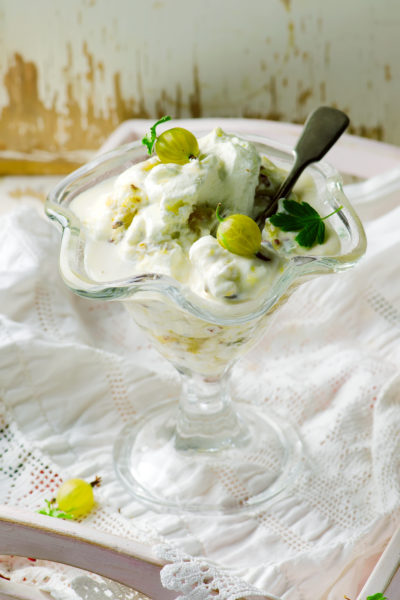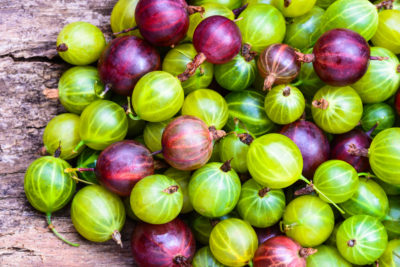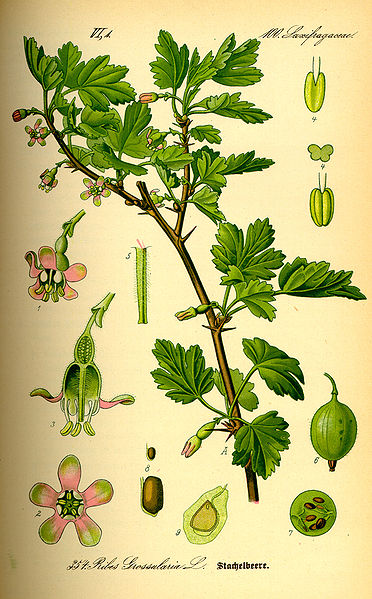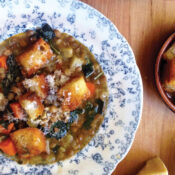Try these delicious and unusual recipes for the gooseberry, aka “sour grape.”
Gooseberry Fool
Originally published in The Saturday Evening Post, May 30, 1868

Gooseberry fool made by the following recipe is much liked by my own family, and has always been highly approved of by any friends who have tasted it:—Wash a quart of full-sized green gooseberries, put them into an enameled saucepan, cover it tightly, and set it on a trivet some distance from a slow fire. Shake the saucepan frequently that the gooseberries may not burn. When perfectly tender, turn them out on a coarse sieve, and rub them through it; and moist sugar to taste, and a little nutmeg. When quite cold mix with them a pint of milk and two eggs very thoroughly beaten, which answer the purpose of cream. Serve either in a glass dish or in custard cups.
Gooseberry Jam
Originally published in The Saturday Evening Post, July 12, 1856
Pick and clean red gooseberries, thoroughly ripe. Boil them by themselves for 20 minutes, skimming them frequently. Then add brown sugar, in the proportion of one pound of sugar to one pound of fruit. Boil for half an hour after the sugar is in. Skim it, and pour it into earthenware jars. When cold, paper up the jars, and set aside in a dry cool situation. Strawberry, and black currant jams are made in precisely the same manner as the above; but instead of brown, use lump sugar.
Green Gooseberry Cheese
Originally published in The Saturday Evening Post, June 2, 1866
Take six pounds of green gooseberries before they begin to ripen; snip them carefully, taking off both ends quite clear; then put the gooseberries into cold spring water, and let them remain for two hours. Then take them out and bruise them in a wooden vessel; put them into a preserving-pan and stir them over a clear fire till they are quite tender. When reduced to a pulp add four pounds and a half of powdered loaf sugar, and boil till the mixture becomes quite thick and is of a good green color. Stir it frequently; pour into moulds.
Gooseberry Champagne
Originally published in The Saturday Evening Post, September 8, 1866
Take large, fine gooseberries, that are full-grown, but not yet beginning to turn red; and pick off their tops and tails. Then weigh the fruit, and allow a gallon of clear, soft water to every 3 pounds of gooseberries. Put them into a large, clean tub; pour on a little of the water; pound and mash them thoroughly with a wooden beetle; add the remainder of the water, and give the whole a hard stirring. Cover the tub with a cloth, and let it stand four days; stirring it frequently and thoroughly, to the bottom. Thin strain the liquid, through a coarse linen cloth, into another vessel; and to each gallon of liquid add four pounds of fine loaf sugar; and to every five gallons a quart of the best and clearest French brandy. Mix the whole well together; and put it into a clean cask, that will just hold it, as it should be filled full. Place the cask on its side, in a cool, dry part of the cellar; and lay the bung loosely on the top. Secure the cask firmly in its place, so that it cannot, by any chance, be shaken or moved; as the least disturbance will injure the wine. Let it work for a fortnight, or more; till the fermentation is quite over, and the hissing has ceased. Then bottle it; driving in the corks tightly. Lay the bottles on their sides. In six months it will be fit for drinking, and will be found as brisk as real champagne.
Gooseberry Wine
Originally published in The Saturday Evening Post, June 8, 1867
Take 40 pounds of nice large gooseberries before they commence to turn ripe, but not before fully grown; remove the blossoms and tails; bruise the fruit without crushing the seeds or skins; add to the pulp four gallons of soft water, stir and mash the fruit in the water until the whole pulp is cleared from the skin ; let it stand for six hours, strain it through a coarse bag or sieve that will not let through the seeds; bring the water and juice to boiling heat, and dissolve 30 pounds of white sugar, and add it to the liquor ; pass a gallon of water through the mass, strain, and add it to the mixture; measure the wine, and add soft water until it measures 10 gallons. Let it ferment as currant wine. Leave the barrel tightly bunged after the fermentation has ceased, until it is drawn off to bottle.
Green Gooseberry Pudding
Originally published in The Saturday Evening Post, May 21, 1870

Line a tart-dish with light puff-paste; boil for a quarter of an hour one quart of goose- berries with eight ounces of sugar and a teacupful of water. Beat the fruit up with three ounces of fresh butter, the yelks of three well-beaten eggs, and the grated crumb of a stale roll. These should be added when the fruit is cool. Pour the mixture into the dish, and bake the pudding from half to three-quarters of an hour.
Some Gooseberry Goodies
Originally published in The Country Gentleman, June 27, 1914
The small, sour, green gooseberry of the old-time garden was neglected with good reason. Numerous thorns made the fruit hard to pick, and the berries made too tedious work to bother with in the rush of preserving season. But now that improved culture has given us big, juicy, fine-flavored berries, which may be quickly prepared for summer desserts and for winter use, the old prejudices are passing and the berry is coming into its rights.
Two Takes on Gooseberry Pudding
A steamed gooseberry pudding, in a deep pudding dish, with plenty of fruit and flaky pastry, is a novelty that is certain to become a favorite dessert. Prepare a rich biscuit dough, roll out to half an inch in thickness, line a pudding dish with it, and fill with large, ripe, tender gooseberries. Sweeten well, with a good proportion of brown sugar or a tablespoonful of molasses added to granulated sugar to give the desired flavor. Cover with a top crust, tie a floured cloth securely over the top of the pudding dish, set it in a covered pan of boiling water, and steam for two hours.
For another form of steamed pudding the gooseberries are mixed directly with the batter. Two tablespoonfuls of butter are creamed with one cupful of sugar, a cupful of sour milk is added, with half a teaspoonful of soda dissolved in a little cold water, and sufficient flour to make a rather stiff batter. Stir in a heaping cupful of gooseberries. At the last beat in the whites of the eggs, turn the batter into a buttered pudding dish, cover closely, and steam two hours.
These puddings may be served with creamy vanilla or lemon sauce. But for variety and novelty try a rich gooseberry sauce, made by cooking the berries in very little water until tender and passing them through a fine sieve. To half a cupful of the smooth pulp add the same amount of sugar and water and boil for a few minutes; thicken slightly with a teaspoonful of cornstarch wet with cold water. When cold beat the white of an egg quite stiff, and with an egg beater combine the thick sauce with the egg.
Multitasking a Bavarian Cream

Gooseberry Bavarian cream is a convenient dessert that may be prepared while cooking breakfast, to be served cold for dinner. Rub a bowlful of hot, stewed berries through a sieve, and to one cupful of the pulp add half a cupful of granulated sugar. Soak a tablespoonful of gelatin in water until dissolved, stir it into a cupful of boiling water, then add the sweetened gooseberry pulp. When it begins to cool beat briskly until it thickens, adding a cupful of rich milk; beat again until thick. Turn into a mold; serve with whipped cream.
Making Roly-Poly
Gooseberry roly-poly may be either steamed or baked for a rich and novel dessert. Sift together one and a half cupfuls of flour, a teaspoonful of baking powder, and half a teaspoonful of salt. Rub in two tablespoonfuls of butter — or one of butter and one of lard — and mix with sufficient sweet milk to make a soft dough. Work lightly with the fingertips, turn the dough on a floured board, and roll into a sheet about half an inch thick. Spread thickly with rich gooseberry pulp that has been rubbed through a sieve and sweetened. Roll up like a jelly roll. Pinch the ends carefully together to keep in the pulp and juice, and tie a thin layer of cheesecloth about the long roll to keep it in shape. Steam for an hour, then remove the cloth, place the roll on a buttered pie plate, and brown for a few minutes in the hot oven. Cut thick slices across the roll and serve hot with whipped cream or a favorite pudding sauce.
One- or Two-Crust Pies
Most gooseberry recipes are improved if the berries are boiled until the skins crack open and then rubbed through a sieve for a smooth pulp. An exception may be made for the two-crust gooseberry pie, which is improved when made with the whole berries if they are of the big, tender, thin-skinned variety. Have the crusts of rich, flaky pastry. Fill the pie plate rather full of berries, as they will shrivel in cooking; add a generous quantity of sugar if the berries are tart, and sift sufficient flour over them to absorb the surplus juice in cooking. Bake quickly in a hot oven until the berries are thoroughly done and the pie well browned. Sift powdered sugar over the top when cold.
For the one-crust gooseberry pie use the rich pulp rubbed through a sieve, with all skins removed. The pulp should be well sweetened while hot and beaten with half a teaspoonful of butter and two tablespoonfuls of cream for each pie. Spread thickly on the under crust, bake in a hot oven, and finish with a meringue, as for lemon pie. Or, if preferred, give a generous coating of whipped cream and powdered sugar when the pie is cold.
An Unusual Salad
Chinese salad is a spicy novelty when served with gooseberries. Wash and boil a cupful of rice. When thoroughly done dash cold water over the rice and drain. Select a pint of gooseberries; chop them lightly, leaving them in rather coarse pieces; sprinkle enough sugar over them to enrich the acid flavor without making them sweet. Make a rich dressing of six tablespoonfuls of olive oil, three tablespoonfuls of lemon juice, and one tablespoonful of soy. Beat the oil and lemon juice until quite thick, add the soy, and beat again until well blended. When ready to serve place the flaky rice on lettuce leaves, over the rice toss the chopped berries, and over the whole place the soy dressing.
Gooseberry and Ginger
For a delicious compote of gooseberries a combination of ripe gooseberries and candied ginger is a favorite relish. Bring a quart of gooseberries to a gentle boil, with a heaping cupful of sugar and a teaspoonful of ginger root minced very fine, or a quarter pound of candied ginger cut in long, thin strips. After simmering until thoroughly tender, remove the berries and ginger to the dish in which they are to be served, keeping the berries as whole as possible. Return the juice to the saucepan; boil a few minutes longer, until well cooked down; then pour it over the berries and serve when cold.
Uncooked berries are best for unsweetened shortcakes made of pastry dough; stewed gooseberry pulp is best for sweet cake. Gooseberry preserves may be cooked down to a rich, heavy sirup, with equal quantities of sugar and fruit, and the skins left in the preserve if the berries are of the thin-skinned variety. If the skins seem tough pass the berries through a sieve after they have been cooked slightly, and use the pulp both for thin preserves and for heavier jam, well cooked down.
Whole gooseberries and chopped ginger root, cooked in a spicy sirup with vinegar and sugar, form a winter relish that is very acceptable with cold meats. Other spices may be used if desired, a little mace and cinnamon blending well with the tart berries in the vinegar and sugar sirup.
Sponge or Float
Gooseberry sponge and gooseberry float are easily prepared desserts to serve after a substantial dinner, while more hearty desserts are dumplings and rich puddings. For the gooseberry float the cooked and mashed berries will be required. Have the pulp quite sweet, and for two cupfuls whip the whites of three eggs, with half a cupful of powdered sugar, until frothy and stiff. Then beat the gooseberries into the frosting, heap the mixture lightly in dessert glasses and serve very cold. Gooseberry sponge is made with gelatin. Half a box of gelatin is soaked in half a cupful of cold water, and then dissolved in hot sirup made by bringing to a boil one cupful each of water and sugar. When cool a cupful of gooseberry pulp is added to the gelatin, with the white of an egg, and the whole is thoroughly beaten until light and spongy.
Better than Apple Butter
A nutritious relish for the children is a spicy gooseberry butter. The gooseberries are simply hulled and boiled in a little sugar-and-water sirup with the favorite spices. The result is richer than the usual apple butter. To two cupfuls of gooseberries allow one cupful of water, one of sugar, and half a cupful of vinegar. Ground cinnamon and mace, a teaspoonful of each with half a teaspoonful of cloves, if the flavor is liked, should be stirred directly into the boiling sirup. Boil until the berries are done and the sirup begins to thicken. Then press through a sieve to remove only the coarsest skins and retain all the pulp possible in a thick mixture. Return to the fire for a few minutes and beat thoroughly while hot, with an extra cupful of sugar, to a heavy butter. The vinegar and spice will keep the butter from souring, and it may be made up in quantity.
Other Ideas
For pop-overs and tarts, for filling patties and gelatin cups, and for timbales and soufflés, the rich, spongy gooseberry pulp, served plain or whipped with cream or white of egg and sugar, may be made to serve a delicious change in company desserts. Plain tapioca pudding is greatly improved by stewing gooseberries with the tapioca. In the different forms of dumplings gooseberries may be cooked whole like cherries.
Become a Saturday Evening Post member and enjoy unlimited access. Subscribe now




Comments
My fondest Gooseberry related memories are of my Mennonite Grandmother’s “Pie By The Yard”. A rich pastry filled with the sour/sweet tang of gooseberries shaped in long strips tasting like a bit of heaven. We took a family trip to the Canadian West and in a honey bucket wrapped around the interior was two or three batches of Pie by the yard. It was worth the constant bouts of car sickness to make it to lunch to enjoy the Gooseberry treat before loading up once again into the back of the old Rambler to travel another 100 miles through the flat western provinces. I was lucky enough to have inherit a Gooseberry Bush as well as Rhubarb Plants when buying my home and have been trying to duplicate those desserts from my past. Alas, there is something about Grandma’s cooking that cannot be duplicated exactly.
Donald Farr
My father found some plants and is growing gooseberries in western Nebraska. Perhaps your climate would do well enough for them too?
Alas, fresh Gooseberries are not to be had here in Phoenix. Sad! If you can find them, they are a delight, with so many delightful ways to enjoy them. My favorite from my Oregon days is the Gooseberry Tart.